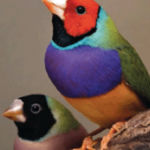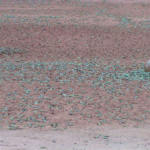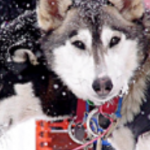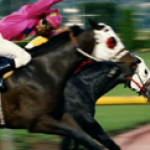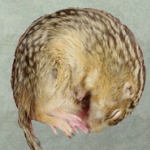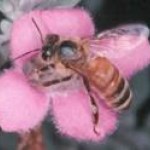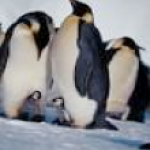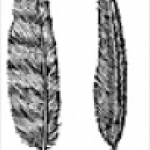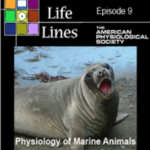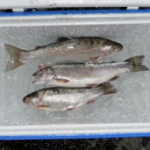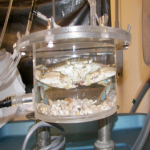
PHOTO CREDIT: SARAH R. PRYKE
Things seem to pile on top of my desk too easily these days. When the stacks finally started tipping over today, I decided it must be time to clean. In this process, I came across a report that I had set aside to read in Science Magazine. So, of course, I abandoned all thoughts of cleaning in order to read this article. In this report, Sarah Pryke et al., describe studies conducted on female Gouldian finches (Erythrura gouldiae) examining their extra-pair mating behaviors.
Individuals in socially monogamous species, like the finches, sometimes copulate with…
Blair Wolf is an associate professor of biology at the University of New Mexico. Research in the Wolf lab focuses on the natural history and ecophysiology of desert animals. He agreed to blog with Dr. Dolittle on the topic of birds. Here is the final excerpt from their exchange.
PHOTO: Budgerigars keeping cool under the shade of a patio during an Australian heat wave, courtesy of Dr. Blair Wolf.
Dr. Dolittle: Would you predict that with global warming, the average body size of birds will increase in hotter areas like the southwestern United States and Australia? Why? What will this mean to…
Blair Wolf is an associate professor of biology at the University of New Mexico. Research in the Wolf lab focuses on the natural history and ecophysiology of desert animals. He agreed to blog with Dr. Dolittle on the topic of birds. Here are excerpts from their exchange.
Dr. Dolittle: What made you interested in studying the effects of Australian heat waves on bird populations?
Dr. Wolf: Australia has a very challenging environment, with a great expanse of hot desert and seems to be THE poster child for the bad things that are associated with climate warming. The continent has recently…
Blair Wolf is an associate professor of biology at the University of New Mexico. Research in the Wolf lab focuses on the natural history and ecophysiology of desert animals. He agreed to blog with Dr. Dolittle on the topic of birds. Here is an excerpt from their exchange.
Dr. Dolittle: Much of your recent research has taken place in the southwestern United States. Do you predict that similar heat waves will occur in this region? Why?
Dr. Wolf: The most current climate research suggests that the southwestern United States is going to get quite a bit hotter and dryer in the next 80 or so years…
Blair Wolf is an associate professor of biology at the University of New Mexico. Research in the Wolf lab focuses on the natural history and ecophysiology of desert animals.
Preface: Dr. Blair Wolf's research discussed in a previous blog released August 13, 2010 on what causes the mass deaths of budgerigars (small birds in Australia) during heat waves sparked much discussion.
PHOTO: Budgerigars killed by a heat wave near a dried-up pond courtesy of Dr. Blair Wolf.
PHOTO: Budgerigars killed by a heat wave in Australia courtesy of Dr. Blair Wolf.
As a result of this discussion I decided to…
As the heat drags on in the southwestern United States, I cannot stop dreaming about sledding through the snow. So I checked out the trusty American Physiological Society press releases to see what the animals might be doing in cold environments that I can only dream about these days.
In my search I watched a really neat video of Dr. Michael Davis (Center for Veterinary Health Sciences at Oklahoma State University) who works on perhaps one of the "coolest" animals (pun completely intended): sled dogs! Oh, how I envy these animals. Racing sled dogs are incredible athletes as they traverse the…
Who doesn't love horses? I was just reading a fascinating archived press release from The American Physiological Society about these icons of all western movies.
Researchers John Hermanson, Norm Ducharme and Jonathan Cheetham (Cornell University College of Veterinary Medicine), John Bertram (University of Calgary, College of Medicine), and Michael Butcher (Youngstown State University, Department of Biological Sciences) examined the coordination of movement and breathing in horses (equine). These systems are reported to work in a concerted effort to allow horses to walk, trot, gallop and run…
Courtesy of Hannah CareyProgram Director, Physiological and Structural Systems
Punxsutawney Phil is best known for his ability to "forecast" whether there will be six more weeks of winter each year. Few people are aware, however, that groundhogs like Phil provide science with even more important information throughout the year. That's because groundhogs are hibernators.
Many animal species, like Phil, enviably spend the winter hibernating including bears, wood chucks, bats hedgehogs, lemurs and some squirrels. Hibernators curl their bodies into tight balls and slow their breathing and other…
One theory of aging holds that accumulation of reactive oxygen species from aerobic metabolism damages nucleotides, proteins and lipids. Therefore, animals with a higher metabolism (poor mice) would be expected to produce more reactive oxygen species and age at a faster rate than animals with a slower metabolism (go sloths!). In a healthy individual, antioxidants help to protect from such increases in oxidative stress. However, this antioxidant capacity declines as we age.
You may be aware that bees transition from working around the hive to foraging at about 3 weeks of age. Foraging is much…
I just watched a re-run of the movie March of the Penguins...so cute! The movie documents how emperor penguins survive their long winter fast while incubating eggs. In fact, researchers have shown that penguins spend about half their time huddling with other penguins. This allows them to lower their metabolic rate by as much as 25%. To better understand this, Drs. Caroline Gilbert, Yvon le Maho, Andre Ancel (Institut Pluridisciplinaire Hubert Curien, Strasbourg) and Martine Perret (Centre National de la Recherche Scientifique and Museum National d'Histoire Naturelle, France) measured the deep…
In the spirit of discussing the effects of climate change, I thought it only appropriate to mention the findings of a recent article by Ozgul et al., published in Nature. The findings of this particular study point to global warming offering a distinct advantage for yellow-bellied marmots (Marmota flaviventis) whose populations have been increasing over the last 10 years. Climate change has resulted in an earlier arousal from hibernation and animals that are giving birth earlier in than previous years, which has promoted larger body masses prior to entering hibernation. This increase in body…
Birds are way cool. In this podcast from The American Physiological Society, Dr. John West at the University of California in San Diego discusses the unique adaptations of the avian respiratory system. In mammals, the movement of air in and out of the lungs in a bidirectional fashion is called ventilation. This air fills the small air sacs (alveoli) which are surrounded by capillaries to aid in gas exchange between the blood and air. In birds, ventilation (controlled by air sacs) is unidirectional and occurs separately from gas exchange, which takes place in the air capillaries of the…
In a recent issue of Science magazine, researchers Li et al., were able to determine the plumage color of an extinct non-avian theropod dinosaur. This was possible due to the presence of melanin-containing melanosomes, which were preserved in the fossilized feathers. The fossilized remains were from a Jurassic troodontid, Anchiornis huxleyi, an ancestor of Archaeopteryx and modern birds. The presence of colored feather patterns in a bird prior to the evolution of true flight, suggests that feather coloration may have evolved for reproductive or communication purposes.
Click here for more…
Caitlin O'Connell-Rodwell is a Stanford University professor whose research focuses on how elephant vocalizations travel through the ground for great distances, and how other elephants can understand them, just as they understand acoustic sound, which travels through the air. O'Connell-Rodwell is the author of The Elephant's Secret Sense. You can see videos of some of the elephant communication experiments she describes in the podcast on her Utopia Scientific site. The links to the videos are on this page.
Early in her research, O'Connell-Rodwell noticed behavior that indicates elephants…
The oil spill in the gulf has me thinking about gators. Have you ever been to a restaurant in New Orleans and enjoyed the tasty alligator selections on the menu? If not, you are missing out. Although I have to admit, they really do taste like chicken. Anyway, you probably know that alligators are cold-blooded because they are ectotherms. But did you know that their hearts are linked to their ability to digest food? It's true! I was just listening to an interview of Dr. Jim Hicks at UC Irvine conducted by Dr. Martin Frank of The American Physiological Society. Many of us are aware that humans…
For all the fellow fish-lovers out there, you must check out this article on a new exhibit of fish bones! Kyle Luckenbill of the Academy of Natural Sciences in Philadelphia has been taking x-rays of fish specimens. The photos were so attractive, they are now displayed in an art exhibit.
I was on a one-day deep sea fishing trip off the coast of Southern California and the topic of diving mammals came up as we were watching sea lions swim around our boat. They must have been attracted to the same school of fish we were trying to catch. I must admit they were more successful at catching fish that day than we were! Their ability to dive and fish in deep waters, which would require an oxygen tank for a human to attempt, was nothing short of impressive. Curious to learn more, I searched for information on The APS website and came up with an interview between Andreas Fahlman and…
I love YouTube! If I could just sit and watch it for eight hours a day, seven days a week, I could probably win a Nobel Prize in Comparative Physiology.
When you get a Nobel Prize, you get the prize itself, a diploma (as though I need another diploma), and of course the Swedish Kroners. I pledge now that should they ever create a Prize in Comparative Physiology, and should I win it, I will donate half of the Kroners to animal research. I am now on record.
Now back to reality.
I just finished watching UCLA's Peter Narins' lecture on frog communication. I learned a lot. Most interesting of all…
I love fishing! I just returned from a weekend fishing trip with my family where we caught these beautiful trout (see photo).
Speaking of fish, I just finished listening to a LifeLines podcast from The American Physiological Society in which Barbara Block from Stanford University discussed her research on bluefin tuna.
Dr. Block uses electronic tags implanted in fish to record information on their location, depth, body temperature, heart rate, food intake, etc. These tags allow her to study the physiology of the animals in their natural environment. Audio clip.
Her research team has tracked…
Photo: Blue crab being monitored for metabolism using a respirometer, courtesy of Louis and Karen Burnett.
Based on information presented at the Global Change and Global Science: Comparative Physiology in a Changing World conference, August 4-7, 2010 in Westminster, Colorado.
Louis Burnett, professor of biology and director of the Grice Marine Laboratory of the College of Charleston and Karen Burnett, research associate professor at Grice Marine Laboratory have been examining the effects of low oxygen and high carbon dioxide levels on the immune system. The results of their research,…
